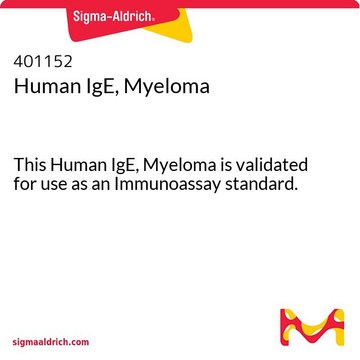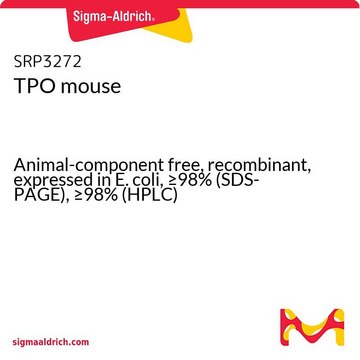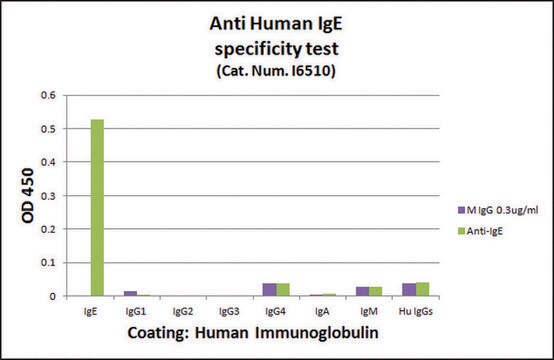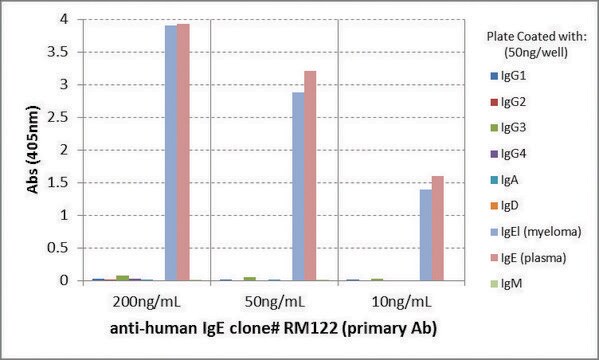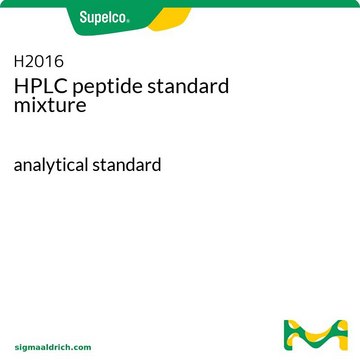SRP4193
IL-33 human
recombinant, expressed in E. coli, ≥98% (SDS-PAGE), ≥98% (HPLC)
Sinonimo/i:
C9orf26, DKFZp586H0523, DVS27, NF-HEV, NFEHEV, RP11-575C20
Autenticatiper visualizzare i prezzi riservati alla tua organizzazione & contrattuali
About This Item
Codice UNSPSC:
12352202
NACRES:
NA.32
Prodotti consigliati
Origine biologica
human
Ricombinante
expressed in E. coli
Saggio
≥98% (HPLC)
≥98% (SDS-PAGE)
Stato
lyophilized
PM
~18.1 kDa
Confezionamento
pkg of 10 μg
Impurezze
endotoxin, tested
N° accesso NCBI
Condizioni di spedizione
wet ice
Temperatura di conservazione
−20°C
Informazioni sul gene
human ... IL33(90865)
Descrizione generale
IL-33 (interleukin 33) is a potent immunomodulatory cytokine that belongs to the IL-1 family, which also includes IL-1β and IL-18. This protein as first identified as a nuclear factor showing predominant expression in human high endothelial venules. IL-33 shows high expression levels in endothelial cells and epithelium, such as keratinocytes, that are in direct contact with the environment.
Recombinant human IL-33 produced from Escherichia coli is a non-disulfide-linked homodimeric, non-glycosylated polypeptide chain consisting of 160 amino acids and having a total molecular mass of 18.1kDa.
Recombinant human IL-33 produced from Escherichia coli is a non-disulfide-linked homodimeric, non-glycosylated polypeptide chain consisting of 160 amino acids and having a total molecular mass of 18.1kDa.
Azioni biochim/fisiol
IL-33 (interleukin 33) functions as an extracellular cytokine, and also translocates to the nucleus where it inhibits gene expression. It acts as a ligand for ST2/ IL-1 receptor-like 1 (growth STimulation expressed gene 2), and ST2 is expressed on cells such as CD34+ hematopoietic progenitor cells, eosinophils, basophils, T-helper 2 cell (Th2), and dendritic, NK (natural killer), endothelial and mast cells. Polymorphisms in this gene as well as its receptor are linked with atopic dermatitis, allergies and asthma. This protein is also thought to function as a profibrogenic cytokine, signaling through ST2, where it facilitates the stimulation and progression of fibrosis in different types of organs and tissues, such as pulmonary, liver, and uterine leiomyoma. In renal transplant recipients, the increased levels of IL-33 might be implicated in the pathogenesis of chronic allograft dysfunction (CAD).
Stato fisico
Sterile filtered and lyophilized with 10 mM sodium phosphate, pH 7.5.
Ricostituzione
Centrifuge the vial prior to opening. Avoid freeze-thaw cycles.
Reconstitute in water to a concentration of 0.1-1.0 mg/mL. The solution can then be diluted into other aqueous buffers.
Codice della classe di stoccaggio
11 - Combustible Solids
Classe di pericolosità dell'acqua (WGK)
WGK 3
Punto d’infiammabilità (°F)
Not applicable
Punto d’infiammabilità (°C)
Not applicable
Scegli una delle versioni più recenti:
Certificati d'analisi (COA)
Lot/Batch Number
Non trovi la versione di tuo interesse?
Se hai bisogno di una versione specifica, puoi cercare il certificato tramite il numero di lotto.
Possiedi già questo prodotto?
I documenti relativi ai prodotti acquistati recentemente sono disponibili nell’Archivio dei documenti.
The Potential Role of IL-33 in Renal Transplant Recipients with Chronic Allograft Dysfunction.
Zhang J et al
Annals of Transplantation : Quarterly of the Polish Transplantation Society, 21, 611-618 (2016)
Esophageal Epithelial-Derived IL-33 Is Upregulated in Patients with Heartburn.
Sei H et al
PLoS ONE, 11(4), e0154234-e0154234 (2016)
Targeting the IL-1 family members in skin inflammation.
Jensen LE
Current Opinion in Investigational Drugs, 11(11), 1211-1220 (2010)
Ying Lei et al.
PloS one, 10(7), e0133774-e0133774 (2015-07-28)
In several clinical and experimental studies IL-33 and its receptor have been found to play important roles in the development of asthma and allergic airway inflammation. We evaluated the effects of vaccination against IL-33 in a mouse model of airway
Elizabeth A Oczypok et al.
The Journal of allergy and clinical immunology, 136(3), 747-756 (2015-05-02)
Single nucleotide polymorphisms in the human gene for the receptor for advanced glycation end-products (RAGE) are associated with an increased incidence of asthma. RAGE is highly expressed in the lung and has been reported to play a vital role in
Il team dei nostri ricercatori vanta grande esperienza in tutte le aree della ricerca quali Life Science, scienza dei materiali, sintesi chimica, cromatografia, discipline analitiche, ecc..
Contatta l'Assistenza Tecnica.